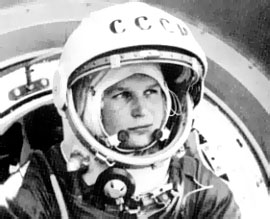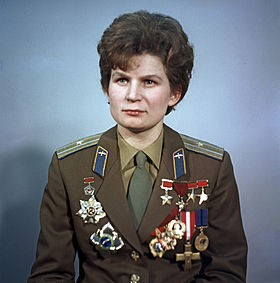Women in Space – Valentina Tereshkova

This article is the first in a series of articles in which I will profile every woman astronaut, cosmonaut and taikonaut who has been into space. The last time I checked 58 women have travelled into space, by the end of this year there may be a few more! We’re going to start this series at the beginning – with Russian cosmonaut Valentina Tereshkova, the first woman in space. (The feature image above is a collection of drawings of women astronauts by artist Phillip J Bond. You can find Phillip’s wonderful series on women astronauts here.)
Valentina Tereshkova
Born in 1937, Tereshkova was a textile worker from Maslennikovo, a small village in the far west of Russia. Tereshkova never yearned to go into space, she left school early to support her family, but continued her education by correspondence. Tereshkova worked in the local textile mill, and earned certification as a cotton spinning technology expert. She went on to become the secretary of the local Komsomol (Young Communist League). Tereshkova’s passion was parachuting. She was introduced to the sport of parachuting by a friend and was so taken by the sport she soon began parachuting regularly and set up the Textile Mill Workers Parachute Club.
In 1962 when the Soviet Air Force advertised for 50 cosmonauts to join the new space program, it included 5 positions for women. At the time Nikita Khrushchev thought that the U.S. was considering sending women from the Mercury Program into space. This spurred the Russians on to select a number of women for their own space program, with the aim of getting them into space before the US.

The requirement to be a cosmonaut did not include any piloting skills, but they did require all applicants to be experienced parachutists, under 170cm tall, under 70kg in weight, under 30 years of age, be fit and be ‘ideologically pure’. Tereshkova met all the criteria. In addition, she was the daughter of a local war hero who had been declared MIA (presumed dead) during the Russian/Finnish war.
Tereshkova was one of 50 out of a pool of 400 applicants that were accepted for further testing. Eventually 5 women passed the assessment test to become a cosmonaut. Over a period of 15 months the 5 women undertook all the same training that the men did, including weightless flights, isolation tests, centrifuge tests, rocket theory, spacecraft engineering, 120 parachute jumps and pilot training in jet fighters. In a 2005 interview Tereshkova recalled that the training was strict and that they were ‘locked inside the classroom to study theory all day long’. As Tereshkova was a civilian she was inducted into the Soviet Air Force as a Lieutenant so that she could become a member of the cosmonaut corps.

Tereshkova was originally intended to launch first in Vostok 5, and another female cosmonaut, Valentina Leonidovna Ponomaryova was to pilot Vostok 6. However, a few months before launch, the flight plan was altered so that Tereshkova would pilot Vostok 6 and Valery Bykovsky would pilot Vostok 5. In an interview Tereshkova was asked if the other members were jealous that she got to fly. She responded ‘The other women were upset – but our friendship is still alive’. She recalled that when she was driven off towards Vosktok 6 for the launch that her back up Irina Solovyova remained in the bus, fully clothed in her space suit, prepared for launch should Tereshkova not be ready or able to launch.
At 1430 hours on 16 June 1963, 26 year old Russian Cosmonaut Valentina Tereshkova blasted into space aboard Vostok 6, becoming the first woman in space. Tereshkova’s mission was to orbit the earth for 24 hours and to conduct a number of tests on herself to collect data on the female body’s reaction to spaceflight. Soon after launch when she settled into orbit Tereshkova realised that the spacecraft was moving away from Earth, rather than heading towards it. She quickly reported the error to ground control, which then provided a new landing algorithm. However, this meant that her mission was extended to 2 days 22 hours and 50 minutes. Because of this, Tereshkova spent more time in orbit than all the U.S. Mercury astronauts combined. At the time there was no mention made of the potentially fatal miscalculation. This information was only released in the 1990s.

Although it’s often reported that Tereshkova got severe space sickness during her flight, in fact she found that it was actually the space food provided that made her ill. However, this had no impact on her performance of her duties during the mission.
Tereshkova orbited the earth 48 times and landed as planned, with only a minor bruise to her nose from impact with her helmet during landing. In November of 1963 Valentina married cosmonaut Andrian Nikolayev On June 8, 1964, she gave birth to their daughter Elena Andrianovna Nikolaeva-Tereshkova, who is now a doctor and was the first person to have both a mother and father who had travelled into space. Tereshkova and Nikolayev divorced in 1982.
After her flight, Tereshkova studied at the Zhukovsky Air Force Academy and graduated as a cosmonaut engineer. She went on to be a test pilot and instructor. In 1977 she earned a doctorate in engineering. She went on to become a prominent member of the Communist Party of the Soviet Union, President of the Soviet Women’s Committee and prominent supporter of women’s rights. Tereshkova is considered a heroine in post-Soviet Russia.

Tereshkova and her fellow female cosmonauts were not considered by some to be a part of the cosmonaut corps, and were not considered for flight assignments on an equal basis with the ‘regular’ male cosmonauts. Unfortunately, during this period space flights manned by women were considered for propaganda purposes. There was fierce competition from the men for a flight position, and placing a woman on the flight would mean that she would be taking the place of a man. An all female Voskhod flight was considered, but eventually cancelled. There is some suggestion that male cosmonauts objected to the women in the corps as a distraction. None of the other four women in Tereshkova’s early group flew, and in October 1969 the pioneering female cosmonaut group was dissolved. Even though there were numerous plans for further flights by women, it was a further 19 years before the second woman Svetlana Savitskaya, flew into space.
Valentina was the recipient of many honours and awards including:
- The Hero of the Soviet Union
- Order of Lenin
- Order of the October Revolution
- Order of Merit for the Fatherland
- Order of Friendship
- Russian Federation State Prize
- United Nations Gold Medal of Peace
- Simba International Women’s Movement Award
- Honorary Doctorate from University of Edinburgh
- Named a crater on the moon ‘Tereshkova Crater’
- Eduard Rhein Ring of Honor
- Asteroid 1671 named Chaika (Her callsign for Vostok 6 ‘Seagull’)
- Joliot-Curie Gold Medal
Tereshkova is now 75 years old, living quietly and enjoying life with her grandchildren. She remains the only woman in history to have made a solo space flight.
Harnett S (2013-02-05 00:20:58). Women in Space - Valentina Tereshkova. Australian Science. Retrieved: Jul 19, 2025, from https://ozscience.com/space/women-in-space-valentina-tereshkova/
 Follow
Follow
Amazing woman! A true pioneer of the space age.
This is really an inspiring piece!!! I request that the story of this self-made woman be made available to the third world to serve as a point of reference to most of our women who easily throw up their hands in despair!!